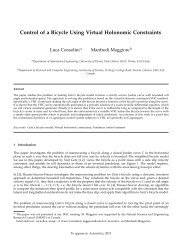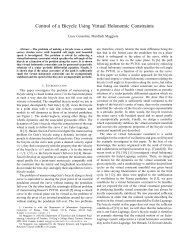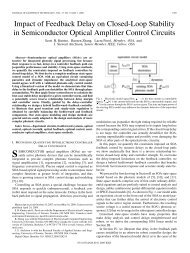State Based Control of Timed Discrete Event Systems using Binary ...
State Based Control of Timed Discrete Event Systems using Binary ...
State Based Control of Timed Discrete Event Systems using Binary ...
You also want an ePaper? Increase the reach of your titles
YUMPU automatically turns print PDFs into web optimized ePapers that Google loves.
Chapter 1. Introduction 3as means <strong>of</strong> control and allows modular supervision, possibly under the constraint <strong>of</strong>partial observation.1.3 Objective <strong>of</strong> the ThesisIn Ramadge-Wonham theory, an automaton (in practice, finite) is used to model both theplant to be controlled and the specification. The RW approach successfully showed theexistence and theoretical synthesis procedure <strong>of</strong> the nonblocking supervisory controller.Different kinds <strong>of</strong> synthesis methods are developed and implemented as s<strong>of</strong>tware CTCT1 for untimed models and TTCT for timed models to compute optimal controllers suchthat the controlled system not only satisfies the specifications but is also as permissive aspossible. However, this implementation <strong>of</strong> RW theory can only solve problems <strong>of</strong> smallstate size. This is because an exhaustive list is used to represent the whole model <strong>of</strong> asystem in TCT. Given that many practical systems have a great number <strong>of</strong> states, TCThas a very limited use in the synthesis <strong>of</strong> practical control problems. The inefficiency<strong>of</strong> this approach is directly related to the assumption <strong>of</strong> ignorance <strong>of</strong> all the structuralinformation in a real world system. TCT uses the easiest way to achieve nonblocking,i.e.exhaustive search <strong>of</strong> entire reachable state space. This has been considered infeasible inits computational aspect.In [30], the exhaustive search is optimized by <strong>using</strong> the structural properties for untimedmodels. This optimization was implemented by Integer Decision Diagrams <strong>using</strong> a s<strong>of</strong>twarecalled STCT. For complex DES systems, STCT <strong>of</strong>fers far better performance thanCTCT.The goal <strong>of</strong> this thesis is to extend the method in [30] to <strong>Timed</strong>-DES. We want to showthat the structural information present in the structure <strong>of</strong> a TDES can be used to op-1 CTCT stands for “C based Toy <strong>Control</strong> Theory”. Originally there was a TCT written in Pascal,which was given the name “toy” because <strong>of</strong> its limited ability to deal with large scale systems. Later itwas rewritten in C and thus got the name CTCT.







